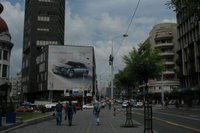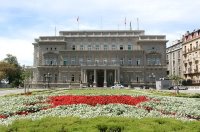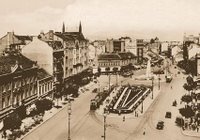BEOGRAD / BELGRADE; a short overview
HISTORY & UNEASY UNIONS;
Belgrade has a long history and there have been many troubles for the city in the last 100 years, let alone it's 7000 year life. It has been the capital of many different nations, from several incarnations of Yugoslavia to the Principality of Serbia and the now defunct union of Serbia & Montenegro. Serbia regained it's full independence from any other state on June 3rd 2006. The short lived co-operation with Montenegro was tumultuous one with many downs and disagreements. One of the major disputes, and most likely one of the major catalysts for separation, was the Serbian & Montenegrin eurovision pre-selection for the 2006 contest. With the Montenegrin judges allegedly swaying the vote so that No Name would for the second consecutive year represent the states. This was a step to far for many Serbians who were still sore from the fact that No name acted like they were solely representing Montenegro in the 2006 contest, by waving the flag of Montenegro and not the flag of Serbia & Montenegro. RTS was not happy with the final, at which No Name were booed off the stage by the largely Serb audience and second placed, Serbian band Flamingosi, sang the reprise. No agreement could be forged between RTS (Serbian) and RTCG (Montenegrin). The fiasco of a national final got more news coverage from national and international press than the death of former dictator Slobodan Milosevic! So they didn't send an entry, and a month later they went their separate ways for good.
GEOGRAPHY & WEATHER;
So back to Belgrade, and what this article is meant to be about. The city lies at the meeting point of the two great rivers, the Sava and the Danube, where the Pannonian Plain meets the Balkan peninsula. Belgrade has a moderate continental climate. The year-round average temperature is 11.7 °C, while the hottest month is July, with an average temperature of 22.1 °C. You can expect an average of 15°C-20°C when you hit the streets in late May.
POPULATION, RELIGION & ECONOMY;
The city has the status of an autonomous region of Serbia, the city government sits in the old palace in the city, which is pictured in the right side bar below. The region of Belgrade is split again into 17 municipalities which each have a local council. The metropolitan area of Belgrade has a population of 1,576,124, according to the 2002 Serbian census. Given that some aspects can't be allowed for in a census, the population of the greater Belgrade region could be near the 2,000,000 mark. The main ethnic groups in 2002 were; Serbs (1,417,187), Yugoslavs (22,161), Montenegrins (21,190), Roma (19,191), Croats (10,381), Macedonians (8,372), and Muslims by nationality (4,617). The Orthodox religion is by far the biggest in Belgrade, accounting for over 95% of the total population, the rest is made up by about 20,000 Muslims and 20,000 Non-Orthodox Christians.
Trade embargoes severely damaged the Serbian economy in the 1990's and hyperinflation made the dinar(national currency) almost worthless. Since sanctions were lifted at the end on the 90's the economy has returned to be one of the strongest in the region, nevertheless the average monthly net income of Belgrade was only €405 as of March 2007.
Trade embargoes severely damaged the Serbian economy in the 1990's and hyperinflation made the dinar(national currency) almost worthless. Since sanctions were lifted at the end on the 90's the economy has returned to be one of the strongest in the region, nevertheless the average monthly net income of Belgrade was only €405 as of March 2007.
And now onto the most important thing, the
NIGHTLIFE;
Belgrade has a reputation for offering a vibrant nightlife, and many clubs that are open until dawn can be found throughout the city. The most recognizable nightlife feature of Belgrade are the barges (splavovi) spread along the banks of the Sava and Danube Rivers. Many weekend visitors—particularly from Bosnia-Herzegovina, Croatia and Slovenia—consider Belgrade more of a metropolis than the capitals of their own countries, due to what they see as the friendly atmosphere, great clubs and bars, cheap drinks, the lack of language difficulties, and the lack of restrictive night life regulation.
Famous alternative clubs include Akademija and the famed KST (Klub studenata tehnike) located in the basement of the University of Belgrade's Faculty of Electrical Engineering. One of the most famous sites for alternative cultural happenings in the city is the SKC (Student Cultural Centre), located right across from Belgrade's highrise landmark, the Beograđanka. Concerts featuring famous local and foreign bands are often held at the centre. SKC is also the site of various art exhibitions, as well as public debates and discussions.
A more traditional Serbian nightlife experience, accompanied by traditional music known as Starogradska (roughly translated as Old Town Music), typical of northern Serbia's urban environments, is most prominent in Skadarlija, the city's old bohemian neighbourhood where the poets and artists of Belgrade gathered in the nineteenth century and early twentieth century. Skadar Street (the centre of Skadarlija) and the surrounding neighbourhood are lined with some of Belgrade's best and oldest traditional restaurants (called kafanas in Serbian), which date back to that period. At one end of the neighborhood stands Belgrade's oldest beer brewery, founded in the first half of the nineteenth century. One of the city's oldest kafanas is the Znak pitanja.
Belgrade also has a small gay scene. The city has only one permanent gay club, as well as a few gay and gay-friendly cafés, in the centre of the city. Intolerance towards sexual minorities is still common in Belgrade and Serbia as a whole. Rumour has also been rife as to the sexuality of Marija Serifovic, many gay Serbian citizens have been heartened by her win and now look forward a mood of more tolerance towards the homosexual community in the city and country.
Famous alternative clubs include Akademija and the famed KST (Klub studenata tehnike) located in the basement of the University of Belgrade's Faculty of Electrical Engineering. One of the most famous sites for alternative cultural happenings in the city is the SKC (Student Cultural Centre), located right across from Belgrade's highrise landmark, the Beograđanka. Concerts featuring famous local and foreign bands are often held at the centre. SKC is also the site of various art exhibitions, as well as public debates and discussions.
A more traditional Serbian nightlife experience, accompanied by traditional music known as Starogradska (roughly translated as Old Town Music), typical of northern Serbia's urban environments, is most prominent in Skadarlija, the city's old bohemian neighbourhood where the poets and artists of Belgrade gathered in the nineteenth century and early twentieth century. Skadar Street (the centre of Skadarlija) and the surrounding neighbourhood are lined with some of Belgrade's best and oldest traditional restaurants (called kafanas in Serbian), which date back to that period. At one end of the neighborhood stands Belgrade's oldest beer brewery, founded in the first half of the nineteenth century. One of the city's oldest kafanas is the Znak pitanja.
Belgrade also has a small gay scene. The city has only one permanent gay club, as well as a few gay and gay-friendly cafés, in the centre of the city. Intolerance towards sexual minorities is still common in Belgrade and Serbia as a whole. Rumour has also been rife as to the sexuality of Marija Serifovic, many gay Serbian citizens have been heartened by her win and now look forward a mood of more tolerance towards the homosexual community in the city and country.
TRANSPORTATION;
Belgrade has an extensive public transport system, which is based on buses (118 urban lines and more than 300 suburban lines), trams (12 lines), and trolleybuses (8 lines). The system is mostly run by GSP Beograd (the City Transport Company) and SP Lasta, in cooperation with some private companies on various bus routes. Belgrade also has a commuter railway network, Beovoz, run by the Serbian Railways. The city's Main Railway Station connects Belgrade with other European capitals, as well as with many of towns in Serbia. However, more popular in Serbia is travel by coach, and the capital is well served with daily connections to all major and minor towns in the country, as well as in the region.
The city is served by Belgrade Nikola Tesla Airport (IATA: BEG), a few kilometres west of the city centre.






























